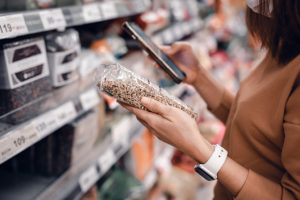

On the subject of wholesome consuming, we all know that recent is greatest.
That doesn’t imply all packaged meals are all dangerous. Savvy consumers can discover wholesome choices—they only have to know the place to look.
That’s the place Diet Info labels are available in.
While you study to decode labels, you’ll be able to higher decide which objects to purchase and which to go away on the shelf, mentioned Kristi Veltkamp, registered dietitian nutritionist at Spectrum Well being.
“Cooking recent is all the time greatest,” Veltkamp mentioned. “However in case you’re going to make use of some processed meals, they’re not all dangerous. That’s the place you wish to be that meals investigator and discover the perfect merchandise.”
The Meals and Drug Administration has made that activity a bit simpler for customers. Key info like serving sizes and energy are actually in a bolder, bigger font.
The FDA additionally required meals corporations to listing added sugars, data that may assist customers scale back their threat of preventable illness.
“If I needed to decide a line that’s most essential, that’s most likely (it),” Veltkamp mentioned. “Sugar might be the motive force of most illnesses—and we get a number of it.”
Take it from the highest
When studying a Diet Info label, have a look at the serving dimension first.
“Lots of people skip that half,” Veltkamp mentioned.
Many assume one can of soup equals one serving, for instance. Typically, one can equals two to 3 servings, which implies you’re getting two to 3 occasions as a lot sodium, fats or different elements.
Meals corporations are inclined to listing small serving sizes, which might make the opposite numbers look higher. If you happen to’re planning on a bigger portion, multiply the quantities of sodium, sugar and energy to get a sensible image, Veltkamp mentioned.
Get your fat straight
Subsequent up you’ll see complete fats, damaged down into two classes—saturated and trans fat.
For a useful mnemonic, keep in mind the “t” in trans fats stands for bother. Avoid it.
“Trans fats is the worst fats you’ll be able to have, so that you wish to hold that at zero,” Veltkamp mentioned. “It’s a artifical fats that will increase the danger of coronary heart illness and excessive ldl cholesterol. There actually is not any secure stage right here.”
Look ahead to trans fat in salty snacks, baked items and margarine.
Meals corporations shouldn’t have to report trans fats quantities if the product incorporates lower than half a gram. However it will possibly present up on the elements listing.
“Any hydrogenated oil is one other identify for a trans fats,” Veltkamp mentioned.
Saturated fat are usually stable and derived from animal merchandise. Assume butter, dairy merchandise and coconut oil.
Veltkamp recommends limiting these to not more than 15 grams per day.
Change into a sugar sleuth
One other key class is carbohydrates.
“I don’t have a look at the overall as a lot as I have a look at the standard of the carb, which has to do with how a lot fiber and sugar it has,” Veltkamp mentioned.
For breads and different grain merchandise, she recommends merchandise with 3 grams of fiber for each 15 grams of complete carbs.
All the time be looking out for added sugars.
“You wish to differentiate between pure and added sugar,” Veltkamp mentioned. “There’s pure sugar in fruits, yogurt and greens. We’re not frightened about these. We’re frightened about what’s added.”
These added sugars are ubiquitous and addictive—and a significant driver of illness.
“It causes irritation, it will possibly have an effect on joint well being, coronary heart well being and clearly diabetes,” Veltkamp mentioned. It could possibly additionally trigger tooth decay, liver illness and excessive ldl cholesterol.
“It’s in every part,” she says. “Condiments, ketchup, barbecue sauce, salad dressing, peanut butter, cereal, yogurt, even crackers and bread.”
The American Coronary heart Affiliation recommends a most of 24 grams a day of added sugars for girls and 36 grams for males.
Sodium and protein
Meals labels additionally embrace details about sodium and protein.
Most individuals ought to restrict sodium to 2,300 milligrams per day. For these with hypertension, coronary heart illness or kidney illness, the quantity must be even much less.
Protein shakes and protein bars have turn out to be more and more common. Nonetheless, most of us solely want about 60 grams of protein per day, Veltkamp mentioned. Protein might be discovered in lots of meals, together with entire grains, greens, nuts, beans, meats and dairy.
“Protein shakes aren’t often needed except you’re utilizing it as a meal substitute or are an athlete attempting to construct muscle,” she says.
Detective work
Along with the data discovered on the Diet Info label, Veltkamp recommends scanning ingredient lists.
“If it’s acquired a number of issues that sound prefer it’s from a chemistry lab, it’s a extremely processed meals and never the best choice,” she says.
With a little bit of detective work and maybe a pair of studying glasses, we will discover wholesome options among the many rows of containers, jars and cans on the grocery retailer cabinets.
“It takes slightly longer, and also you’ve acquired to be that meals investigator,” Veltkamp mentioned. “There are meals which can be wholesome. You simply must search for it.”

